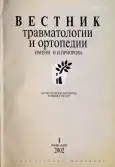Residual stability of the craniovertebral segment in its various injuries
- 作者: Vetrila S.T.1, Kolesov S.V.1, Gavryushenko N.S.1
-
隶属关系:
- Central Institute of Traumatology and Orthopedics. N.N. Priorov
- 期: 卷 9, 编号 1 (2002)
- 页面: 25-29
- 栏目: Articles
- URL: https://journals.rcsi.science/0869-8678/article/view/97085
- DOI: https://doi.org/10.17816/vto97085
- ID: 97085
如何引用文章
全文:
详细
Residual stability of craniovertebral segment in the most common injuries (odontoid process fractures, ring fractures of C2, Atlas fractures, etc.) was sudied in experiment. The study was performed in 7 cadaveral craniovertebral blocks. The range of movement before and after injuires modelling, the estimation of force that caused the vertebrae displacement using special loading test device were detected. It was shown that in any injury without vertebrae dislocation craniovertebral segment possessed the residual stability. The minor stability was noted in odontoid prosess fractures of II and III types and «butcher’s»fractures, the major stability was in the intervertebral disc injuries of C2-C3 and occipital condyle fractures. On the base of experimental and clinical data the conclusion was done that fixation of cervical spine using head support with frontal fixative or halo apparatus were indicated for cranivertebral segement injuries without vertebrae dislocation. In dislocation of vertebrae it was necessary to reduce the dislocation and open surgical intervention for stabilization.
作者简介
S. Vetrila
Central Institute of Traumatology and Orthopedics. N.N. Priorov
编辑信件的主要联系方式.
Email: info@eco-vector.com
俄罗斯联邦, Moscow
S. Kolesov
Central Institute of Traumatology and Orthopedics. N.N. Priorov
Email: info@eco-vector.com
俄罗斯联邦, Moscow
N. Gavryushenko
Central Institute of Traumatology and Orthopedics. N.N. Priorov
Email: info@eco-vector.com
俄罗斯联邦, Moscow
参考
补充文件












